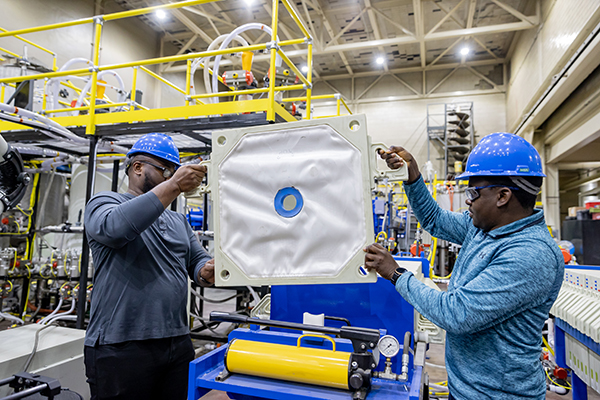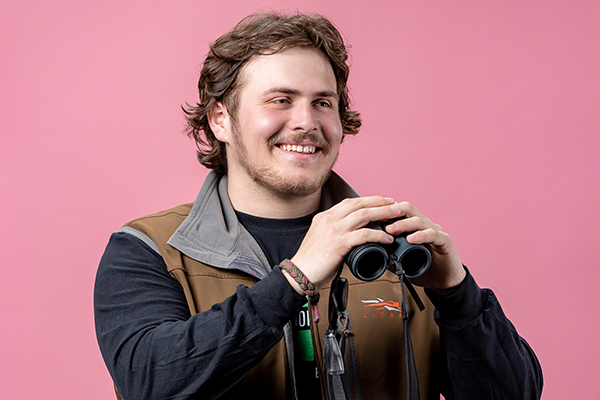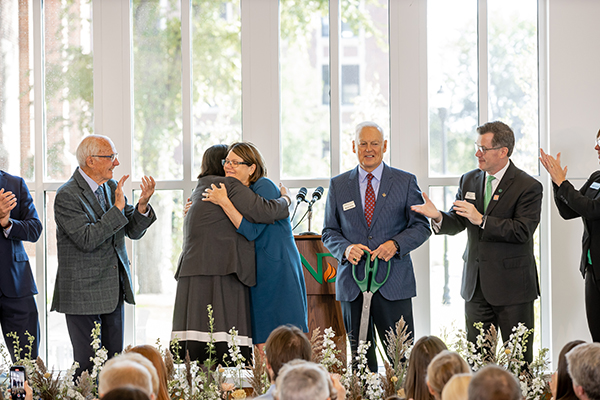Photography
Imagery is a powerful resource to tell the UND story.
Use our brand guidelines to find the best ways to access, select and use UND photos to strengthen your message. For additional photography standards and techniques, complete brand training.
Accessing and Requesting Photos
Campus has access to an online public photo library maintained by the University Photographers. The collection illustrates a wide range of UND programs, activities and locations.
The online public library photos may be used for official University purposes. By using the UND public photo library, you agree to the UND Photo Use Requirements and to retain the naming structure of downloaded photos. If photos are renamed it makes relocating that image incredibly in the larger UND photo archive.
Photo Library Search Tips
Photos in the public photo library are labeled with tags that help identify people, places, and items. You can use the search function to find photos that fit your project. Here is a sample of tag used on photos:
- Names and titles of known people in photo
- A unit or org that may be associated with photo
- Location details (quad, fountain, building, road, sidewalk, residence hall)
- Major (biology, art, English)
- College (Business, Law, Nursing)
- Season (fall, winter, spring, summer)
- Items in photo (laptop, bike, calculator, backpack, glasses, books)
- Colors present in photo
- Emotions (happy, smiling)
- Nature details (snow, rain, sunset, river, trees, clouds, water)
- Photo style (silhouette, portrait, tilt-shift)
- Verbs (walking, jumping, laughing)
- Hands-on learning (learning that is not simply sitting in classroom)
- Internships
- Online learning
- Town and gown (students engaging with the city of Grand Forks)
Note: Photos are tagged using UND terminology so please use proper UND terms when searching, not more general terms. For instance, search Commencement, not graduation, and residence halls instead of dorms.
Archived Photos
Requests for additional archived photography may be submitted to marketing@UND.edu.
Event Photography Coverage
Marketing
The UND photographers primary focus is to capture the UND experiences that can be used on a broad scale to support affinity to the University.
Photography requests for events are prioritized by current archive selection, photo category, the scope of the distribution plan and photography staff availability.
Communications
The UND Communications Team focuses on photography related to news releases and UND Today story subject matter. Stories covered need a human-interest aspect and must have campuswide appeal.
Requests are prioritized by the subject matter's human interest, the scope of the distribution plan and staff availability.
Award Ceremonies & Luncheons
The Division of Marketing & Communications may cover award ceremonies or luncheons as news events or to capture images that may be used in broad marketing for UND. If you or your department have event photography needs for award winners, please contact marketing@UND.edu to learn more about the following options:
- Freelance and Pre-Approved Vendor List: Marketing & Communications maintains an up-to-date list of freelancers and pre-approved vendors for areas to use. Budget is required and coordination is led by the requestor.
- Cell Phone Photography Tips: This option is a good solution when the event coordinator wants fast delivery for social media and other needs.
- Access to Employee Headshots: Headshots can be used in communications to recognize award winners, such as department newsletters. Marketing professionals in each unit, school or college have access to these images via Canto.
- Photo Station: For larger, student-focused events, Marketing & Communications can provide a branded photo area to take celebratory photos. This includes a backdrop, an iPad, a tripod and post-event photo delivery.
Photography Services
Photography requests made by campus partners are prioritized by photo category, the scope of the distribution plan and photography staff availability.
Requests for photography services may be submitted to the Marketing Project Request Form.
Photo Distribution
Primary
- UND website
- Admissions recruitment print materials
- Admissions recruitment emails
- Main UND social media accounts
- Recruitment presentations
- Admissions visits
- College visits
- Digital and print advertising
- UND public photo library
Secondary
- Administrative communications (campus-wide initiatives, presentations, etc.)
- Campus branding
- UND Today and research communications (broad distribution content only)
- Campus and Alumni publications (broad distribution content only)
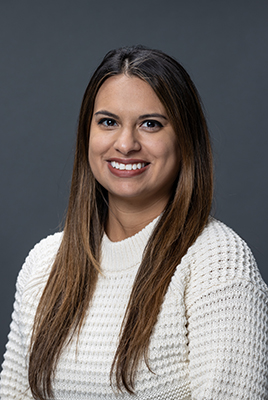
A headshot is captured on a standard background in Marketing & Communications' photo studio. It is used for professional business purposes.
Professional headshot services are available to University faculty and staff. The Division of Marketing & Communications holds a Headshot Day once a month.

A portrait is a unique image used to portray a personal feel and sense of place.
Environmental portraits do not replace the use of a professional headshot. Instead, environmental portraits are used to convey a personality, tell a story or share more information about a person’s connection to UND. The Division of Marketing & Communications schedules environmental portrait sessions outside of monthly headshot times.
Portraits are shot in-studio or on location. If shot on location, a UND space that provides a sense of place instead of a generic space is recommended. Marketing & Communications provides limited environmental portrait services open to:
- UND senior administration (President, Vice Presidents and Deans) are eligible to request environmental portraits in addition to their professional headshots.
- Admissions reps receive the opportunity for an environmental portrait once a year due to their recruitment roles with external audiences.
- UND faculty, staff and students may be asked to take an environmental portrait if they are featured by Marketing & Communications for work associated with the university.
Both UND headshots and environmental portraits are used to promote an individual’s work at, or connection to, UND. They cannot be used for personal gain.
Photography Best Practices
Selecting photography that emphasizes the great community of UND for your project can be an exciting and overwhelming task. Use the following information to ensure your selection engages the audience and follows brand standards.
- We use photos of UND students, faculty and staff putting their passion into action and making an impact
- We use bold and expansive shots of campus to express the breadth and beauty of our home.
- Photos need to be in focus. If the focal point of the photo is not in focus, the photo should not be used.
- Select photos that enhance content and provide a clear message. Use critical thinking
to analyze selections while asking:
- What story is it telling?
- Does it need a caption to be clear to the audience?
- Based on the goal, how does it work with the other photos used in the piece?
- Is there enough variation amongst the photos (focal lengths, composition, detail, content, etc.)?
- Does the photo fit the frame?
- Does the selection need to show a unique aspect of UND and/or a sense of place?
- Photos and graphics must be the property of the University or used with appropriate
permissions from the owner(s). Photos taken by and are property of UND are preferred.
- Stock Photography: Avoid stock photos and clip art. If you use stock images, ensure that you have purchased a license or gained legal permission.
- Prevent pixelation by using the exact measurements and minimum resolution needed. Print resolution is 300 ppi. Digital resolution is 72 ppi. For more information on sizing and editing images for the web, visit web support.
- Our brand focuses on color photography. Black-and-white photography can be used for historical examples, print limitations or for specific marketing campaigns that have been approved by the Division of Marketing & Communications.
Photo Selection Best Practices
Variation
- Use bold and expansive shots to express the the beauty of campus.
- When selecting photos for a multiple photo spread, choose images that have complimentary colors, and that also have a variety of focal lengths like wide, medium and tight.
Focus
Check the focus in a photo to ensure it is on your main subject, especially if cropping. In this example, the focal point was off and we needed to swap to another photo.
Fit
Selecting photos for the UND website can be challenging because of the horizontal nature of web photos.
Photo Selection Limitations
Photo Frames
Limit the use of difficult photo frame sizes like an extra-long and short rectangle or when cropping with our brand’s 56-degree angle.
Focal Point
Adjusting the crop on a photo to highlight secondary subjects, even if those subjects are in focus, is not recommended. The strength of the photo’s storytelling is centered on the main subject and adjusting the focus weakens or removed that story.
Changing Orientation
Cropping a landscape photo to a portrait orientation, or vice versa, often removes important content from the photo. Using photos in their original orientation takes priority
Scale
When selecting a photo keep the scale of the deliverable in mind. For instance, do not put detailed images in a piece that will be seen small. Instead, select a photo with a simpler composition.
Use the following information to ensure your photos follow brand standards.
Traits
Primary brand traits are action, movement and connection. Select traits to feature based on what will engage the audience and meet any additional shoot goals.
Action
Student expressions and gestures capture the experience.
Movement
Special photography techniques show how students move through a space.
Connection
Focus on the subjects’ expressions, surroundings and use framing to authentically capture connection. Unexpected angles can also draw an audience into a focal point in a different way, which forms a connection through user experience.
- An unexpected angle draws the audience into the photo.
- Student expressions and body language imply friendship and connection.
Techniques
In addition to brand traits, the subject, location and lighting will prompt what photo techniques to use.
Unique Subject
If you are capturing something unique to UND, how will you highlight the uniqueness? How will you get the audience curious about what it is? Will the story or context best be shown using wide, medium, tight or detail shots?
UND Space Studies and our UND space research is a unique selling point.
Generic Subject
It is hard to make something every university has feel unique or engaging. When photographing a generic subject, focus on color, depth of field, an unexpected angle, dramatic lighting, developing a sense of place or unique framing to make a photo more engaging.
Many residence halls across campuses can look similar. UND branded items were added to this shoot to provide sense of place.
Lighting
Generally, our lighting style is natural. Sometimes more dramatic lighting is used for specific reasons, such as adding contrast, creating depth, or helping with unique framing. More typically, we are trying to light a scene in a natural way, so the photos feel authentic and relatable.
Available Lighting
Sometimes we need to shoot with the available light. At events or meetings, using artificial light can be distracting or simply not needed.
Series Lighting
Specific lighting concepts that vary from our brand standards may be approved by Marketing & Communications for unique marketing campaigns.
Artificial Lighting
Artificial lighting is used in the studio or on location. When used on location, it is mainly to improve the lighting in the space in which you are shooting. Artificial lighting tips:
- Bouncing a light off white walls or ceilings can provide a natural, bright look in photos.
- Turn off overhead lights to avoid mixed white balances. · When using colored lights or gels, keep colored lighting off face as it can look unnatural.
- If a light or light stand accidentally finds its way in a shot, crop or edit it out
Composition
- Be deliberate in photo composition to create well-framed subjects.
- Use higher f-stops in wide photos to place more of campus in focus.
- Avoid placing too many out of focus items, like backs of heads, in the foreground.
Studio Photography
The UND studio space allows the UND photo team control of every aspect of the photo – the lighting, the background, the talent, the props, the wardrobe – to convey a specific message.
Toning
UND photos should look natural when printed.
- Use a consistent white balance and make sure skin tones are true to their natural appearance.
- Avoid overuse of saturation, clarity and contrast toggles in Lightroom/Photoshop.
- Presets and third-party filters are not used.
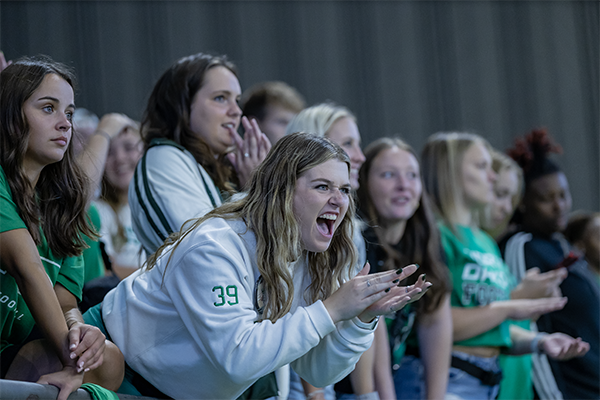
Before
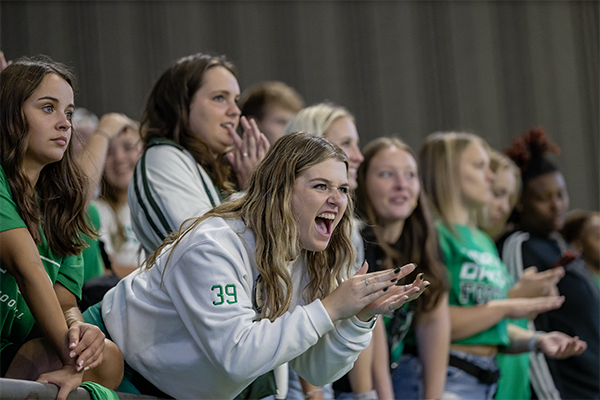
After: Photos from the camera can have an incorrect white balance. Here, more warmth was added to the original photo.
Editing
Edits made must be minimal and ethical. Manipulating a photo to change the subject matter or negatively mislead the audience is not acceptable.
Acceptable edits include removing temporary elements (construction, acne, glare, fly-away hair, scratches, etc.) or removing a distracting object, like an outlet, from the background of a photo. However, removing an item that changes the message of the photo or adding something not originally present to a photo is not acceptable.
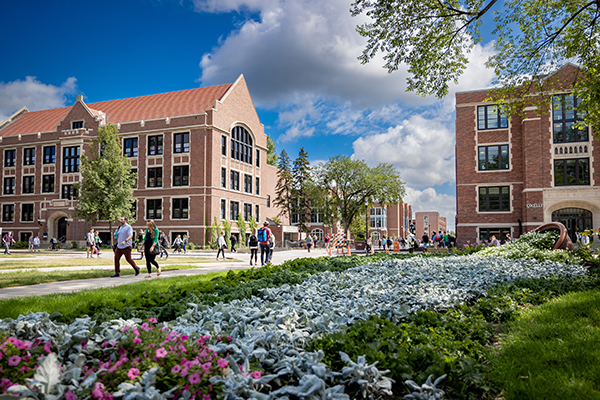
Before
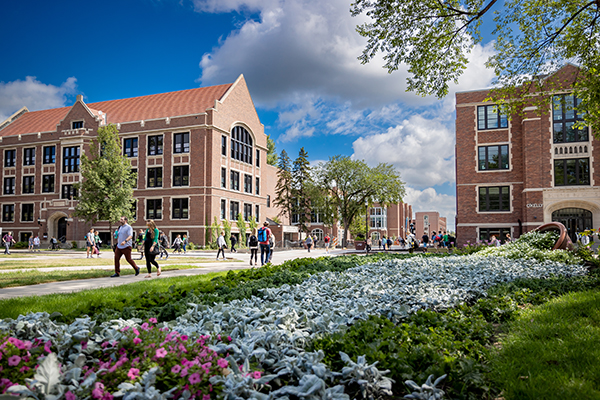
After: Construction items were removed to reduce visual distractions.
Cropping
Cropping can be a useful technique to strengthen the final image. Follow these tips when cropping:
- Crop out distracting elements, such as partial figures or out of focus objects. · Use cropping to adjust horizontal lines.
- Retain the original ratio when cropping. A 3:2 ratio is common.
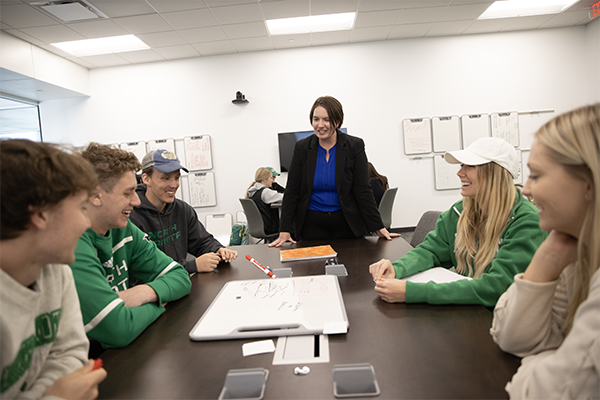
Before
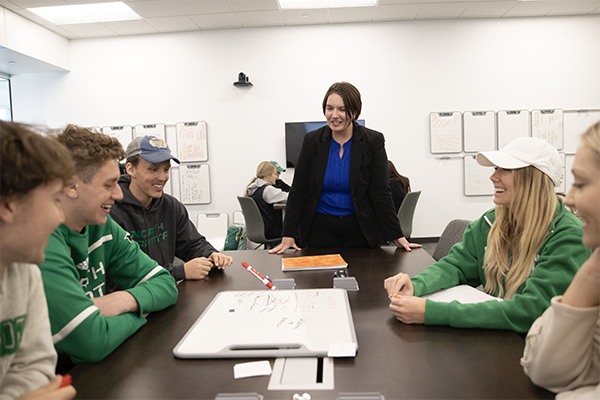
After: Cropping to adjust horizon lines is OK.
Naming
A consistent naming system is important for file organization. Use the following photography naming structure:
- Include the shoot date, shoot name or other logical descriptor and file number.
- Letters are lowercase and hyphens are used in place of spaces.
- Structure: YYMMDD-shootname-filenumber.JPG
- Example: 220420-chemistry-0682.JPG
Retain the date and shootname once downloaded from the archive, but additional descriptors (i.e. billboard) can be added for clarification.
Photo Use Requirements
The University of North Dakota Division of Marketing & Communications uses and distributes images of academic activities and campus life to promote the University and to advance the University’s educational goals. Images of University employees and students involved in campus life activities, images of visitors to campus in public spaces or engaging in public events, or participants in University-sponsored events off campus might be captured for these purposes. Our Image Use Requirements govern images captured by UND employees and by vendors contracted by the University for these purposes.
These requirements are applicable to all University areas, including offices, departments, divisions, centers, institutes, programs, and schools.
Internal Use
The use of University images in any print or digital medium is restricted to the representation or promotion of the University, its programs, events and activities. For example, photos can be used to promote, inform or represent the University in PowerPoint presentations, marketing materials, and websites. Personal use of University images is not allowed. Images cannot be modified in any way (cropped, color conversions), sold, distributed, incorporated into another work, used to create a derivative work, or otherwise exploited in any way.
Campus departments should not use any images for marketing purposes that were captured by someone other than a University employee without either a professional services agreement in place, granting the University rights to the images or a written consent and release from the external photographer/creator of the image.
External Use
Before granting permission and releasing photos to external clients, the University must receive in writing the planned use of the images. The University reserves the right to revoke permission if the photo use isn’t clearly stated or if the images are used improperly.
As state-owned property, University images cannot be used to promote private businesses or other entities. The University will distribute photos with a goal of promoting and representing the University.
Photo Credit
When photos are used in promotional pieces, presentations, websites and/or slideshows, a photo credit is not necessary.
When photos are published in a magazine, newspaper or other media, we require our photos to be credited to the University of North Dakota.
Minors in Photos
UND’s Division of Marketing and Communications does not use photos of children in marketing materials unless the child’s legal guardian has signed a consent form. In social media and news photos, minors are allowed when they are part of a crowd attending an event.
